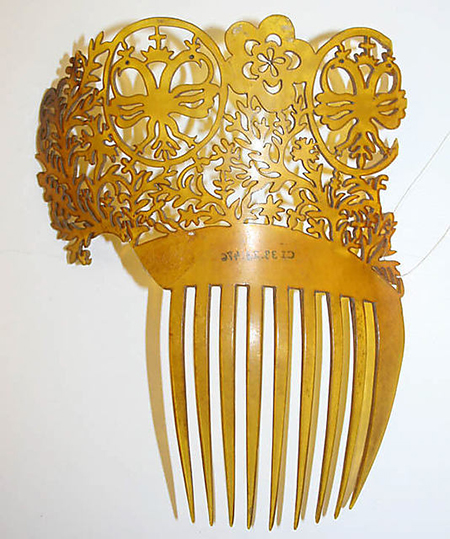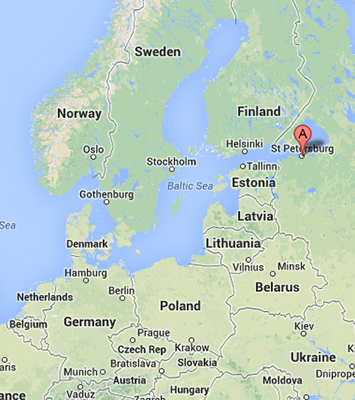The description the museum gives is
- Date: 1700 – 1938
- Culture: American or European
- Medium: Bone.

In 1705, Tsar Peter the Great wanted to rid Russia of its technological backwardness and import Western style and ideas. He looked to France and founded St. Petersburg by the Neva River, east of the Gulf of Finland because he understood the strategic importance of the Baltic Sea. Trade became plentiful. This established St. Petersburg as more a part of Europe than the rest of Russia.

This comb looks like it was hand carved from clarified horn that came from a horse’s hoof, a popular material in Germany.
The comb was probably made in the 19th Century, both stylistically (Russian Coat of Arms) and by this inscription: C.I.38.23.476. In Russian, C.I. means I.D. Together with the number, it is most probably a proof of the comb’s presence in some sort of Russian museum or collection.
It is very difficult to believe this comb could have been made in America, or after 1917.
I don’t understand the Metropolitan Museum’s description. I will ask them. Comments welcome.
कंघी
For more scholarly research, please examine our Resource Library and
 Jewels of the Romanovs: Family & Court |
 The Comb: Its History and Development |
 Russian Elegance: Country & City Fashion from the 15th to the Early 20th Century |

thanks Barbara for this posting…
to look at a photograph is normally not enough for perfect description…
it doesn’t look at all like bone…blond tortoise would fit the description much better…
as for the age I would guess around 1880 – 1910….
OK, I will reflect that. Thank you! I had some other comments, I’m editing in, as well.
There are two similar combs at the moment for sale on ebay Germany (not expensive, but damaged):
http://www.ebay.de/itm/SEHR-SCHON-GEARBEITETER-ALTER-HAARSCHMUCK-KAMM-STECKKAMM-WOHL-HORN-SCHILDPATT-/271254843229?pt=DE_Mode_Accessoires_Schmuck_Schmuck&hash=item3f280c6f5d
http://www.ebay.de/itm/SEHR-SCHON-GEARBEITETER-ALTER-HAARSCHMUCK-KAMM-STECKKAMM-WOHL-HORN-SCHILDPATT-/281148555657?pt=DE_Mode_Accessoires_Schmuck_Schmuck&hash=item4175c28189
I also own one like these, but it’s unfortunately broken :(
(if you’re interested to see it, I might take a picture and send it to you)
As I’ve bought this one in Germany (Munich), where also the combs on ebay are sold, this might be a hint already to where they come from?
Thank you very much for this information. We have already written to the Met with very much the same opinion. The eBay listings add a nice touch, I think. :-)
Rather a late comment I’m afraid but to me it looks like clarified horn rather than hoof as it seems to be very evenly clarified. I agree with the German attribution and probably dates around mid 1800s, a little later than stated above. See page 204 Fig 8.5 in my book – this one is in a museum in South London and came from a specific collection purchased in the early 20th century. Sometimes horn was referred to as bone, incorrectly, in early descriptions, but this is definitely cattle horn.